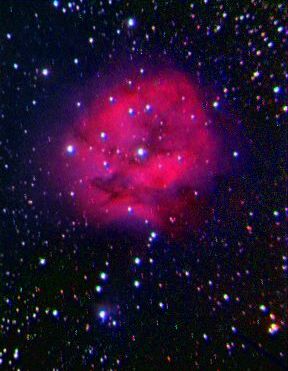

IC 5146, in the constellation of Cygnus, is about 9° north-west of North America Nebula (NGC 7000), and 3° 44' from M39. It was first described by Thomas Espin in 1899. Espin was a Britsh clergyman who owned 18-inch and 24-inch telescopes. Although the nebula is quite bright to a modern CCD camera, it is quite faint visually because its main emission is at the Hα wavelength to which the eye is relatively insensitive. It is described as an emission/reflection nebula because it has characteristics of both. The strong red colour is caused by the fluorescence of Hydrogen (Hα) but there appears to be very little emission from Oxygen (OIII). The blue haze around the nebula is the reflection part. Both emissions are believed to be caused by the very bright and young star (a few hundred thousand years old) at the centre of the nebula.
The nebula is about 15 light-years across, and lies 4,000 light years away.
 |
This picture was made from pictures taken with an IR-block filter, Hα and OIII filters and the blue filer from the LRGB filter set. In constructing the colour image, the Hα image was used for the red channel, the OIII image for the green, and the IR-blocked image was used for the luminence channel. This gave rise to rather yellow stars, so I rebalanced the colours to make the brightest stars white. I normally orientate my images with north at the top. I have remounted my LX200 on a GEM and I remain uncertain how to orientate my camera. Images on the internet are in all sorts of orientations but this orientation corresponds to an APOD. Date and Time: 12th September 2015 20:37 to 22:43 UT Camera: MX716 Telescope: LX200-10 with 0.33 focal reducer Capture: star_mx7. 120" exposure Processing: star_mx7. Background, non-linear stretch 25. Converted to png files in Irfanview; converted from indexed to greyscale in PhotoImpact. Drift due to imperfect tracking corrected by Focus Magic in PhotoImpact. Registax5. Stacked 9 or 10 frames at each wavelength, gamma 1.5. Four pictures (L, R, G, and B) combined in RegiStax. |
My original intention was to image with conventional LRGB filters, but light cloud came in and spoiled the green capture so that the LRGB image had a green sheen in the wrong places. Fortunately I had captured images in Hα and OIII. The latter picture showed no sign of the nebula.
Home Back to DSOs